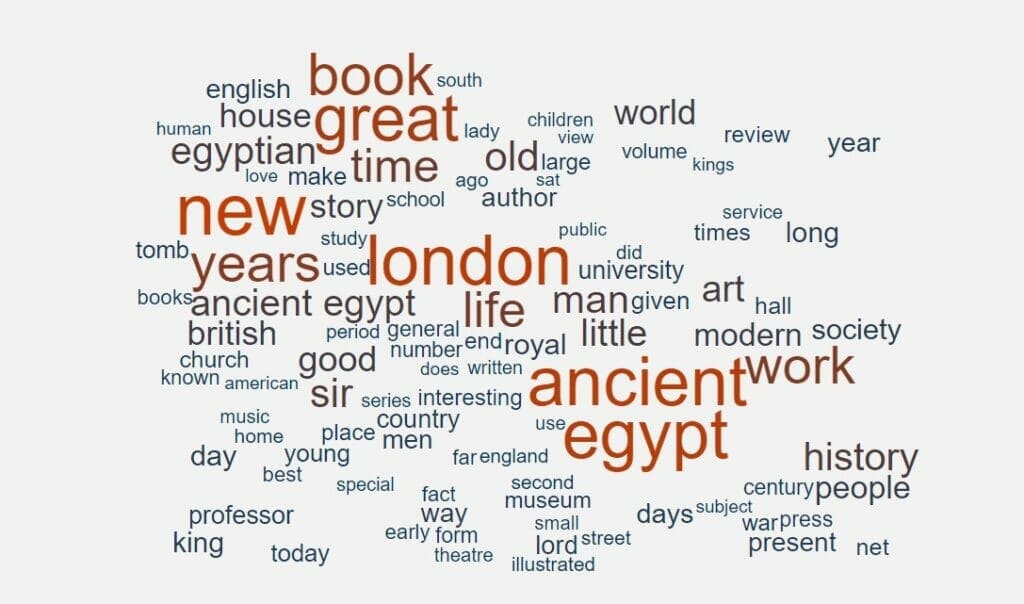│By Tamar Atkinson, Gale Ambassador at the University of Liverpool│
Primary sources can be a great resource for Master’s dissertation research, providing a deeper understanding of history. Whilst they make handy supportive evidence to back up the points you want to make in an assessment, is there a way to take them further? Within Gale Digital Scholar Lab, you can find a whole range of data-mining visualisation tools and other resources that can allow you to bring elements of Digital Humanities methodologies into your research, through an easy, step-by-step process. This can add great insights to any work!
I was interested to know what I could learn through this tool as an Egyptology student, and decided to see what the perception of Egyptology was during the 1920s-1940s. This was a key period within the field of Egyptology, with significant publications produced and numerous important excavations, such as the works of John Garstang, Flinders Petrie, and of course, the excavation of the tomb of Tutankhamun by Howard Carter’s team.
Digital Humanities tools in Gale Primary Sources
This choice of date range for my research was also reinforced through an initial Advanced Search on ‘Ancient Egypt’ across Gale Primary Sources, and use of the Term Frequency tool (one of the tools in Gale Primary Sources), which showed a spike in publications at this time. It was from here that my case started to form.
I also used the Topic Finder tool in Gale Primary Sources, before moving over to Gale Digital Scholar Lab, to get an idea of themes that were cropping up in relation to Egyptology. From this, it seemed clear to me that most of the public discussion centred around new excavations taking place at the time, new finds being displayed in Britain and other public events or recent publications within the field of Egyptology.

Initial Stage: Building a Case
Once this was established through use of Topic Finder tool, I moved over to the Gale Digital Scholar Lab. Here I used several search filters to produce the results I would use in my dataset, ensuring all sources were produced in English and from England to avoid any inconsistencies that may have arisen from the analytical tools. I was also then able to check the individual sources to make sure they were relevant to what I was wanting to find out, weeding out any data that I thought would skew the results.
Using the ‘Build’ section, I was able to carefully curate the sources that would form the basis of my results, which made putting the data together much easier, and allowed for the next stage of my research.

Trial and Error: Creating a Clean Configuration
The next way to make sure my primary sources were ready for research was through the ‘Clean’ stage. This step is the most important for research, allowing you to edit your sources in a way that best suits your analysis. For me, this meant making sure common words like ‘the’ and ‘a’ wouldn’t crop up in my results, so that I could see the more common key phrases, as well as making sure numbers and special characters were removed and that any Egyptological phrases would present with a consistent spelling.
This took a lot of playing around with to get used to, and involved experimenting by running the analysis to see if any details had been missed out. Luckily, the Test Your Configuration feature allows you to review your configuration on a sample of sources to make sure all is going according to plan, meaning I didn’t have to keeping going back on myself.
Once I was happy with how things were playing out and I had adjusted everything, it was time for the core step: Analysis!
Analytical Tools: Investigation and Insight
The ‘Analyze’ step is where the magic happens. Gale Digital Scholar Lab provides you with a good variety of tools that produce different types of analytical visualisations, so it was important to select the ones that would be most useful for my research. As I was wanting to look into the perception of Egyptology at this time, I chose to use the Sentiment Analysis, Ngrams and Topic Modelling tools, as they would all provide me with a great look into how Ancient Egypt was being discussed in the data. Once I selected my tools and configuration, it was a simple click of a button, a short wait for the program to run and hey presto: results!
The first insights I obtained came from the Sentiment Analysis tool. Whilst at first some of my documents failed to be added to the data points (which some more tweaking in the ‘Clean’ stage could quickly fix!), I was able to gain a clear picture of how Ancient Egypt was generally being received in the media. The overall content set sentiment seemed to be 0.843, indicating that, with some exceptions, Ancient Egypt was being thought of positively in publications. This allowed me to to understand there was a sense of enthusiasm and interest around the topic from the public.
Ngrams allowed me to delve deeper, seeing what sorts of words were cropping up the most. As seen in the cloud visualisation below, the most popular terms included: ‘new’, ‘great’ ‘book’ and ‘work’. This seems to imply most discussions being presented were related to the range of new discoveries and information coming out during this time period, shaping the media at large.
Finally, Topic Modelling allowed me to make further inferences on the perception of Ancient Egypt during this period. From the generated topics, with common words being ‘university’, ‘book’, ‘history’ and ‘work’, we can see that academic research is a highlight of Egyptological discussions during this time. However, we can also see another theme of ‘theatre’, ‘music’ and ‘new programme’ close behind, suggesting the appearance of Ancient Egypt within popular culture was also becoming increasingly common.

Through using the tools provided by Gale Digital Scholar Lab, I was able to gain insight into the world of Digital Humanities and gain information I would never have gathered from simply reading individual sources. But what I have demonstrated here only scratches the surface of the potential of this tool! There’s so much more one could unearth and analyse about a historical topic using these tools. Thus, through making the most of accessible DH resources like this, any assessment, dissertation or research could be enhanced via use of Digital Humanities.
If you enjoyed reading about using Gale Digital Scholar Lab for Master’s level research, check out:
- Separating the Wheat from the Chaff: Identifying Themes and Topics in Archives Using Gale Digital Scholar Lab
- How Gale Digital Scholar Lab Could Support Alternative Research Methods
- Digital Humanities and Data Mining: The Key to Efficient Seminar Preparation
- Investigating the Evolution of Twenty-First Century Pop Culture Using Digital Humanities Techniques
- Working with Datasets, A Primer
Or explore more widely, and view all posts tagged Digital Humanities.
Blog post cover image citation: Sentiment Analysis of results relating to Ancient Egypt from 1920-40, created using Gale Digital Scholar Lab.






